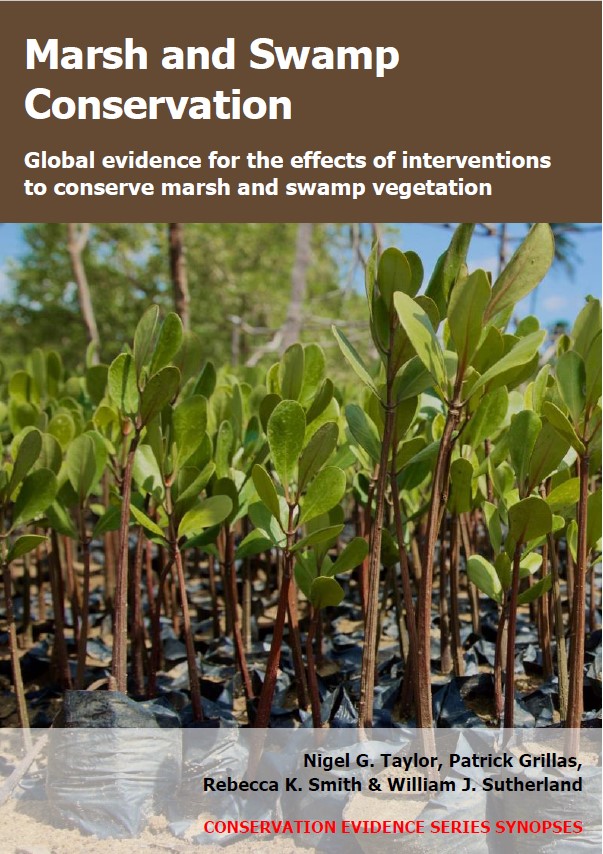Add inorganic fertilizer before/after planting non-woody plants: freshwater wetlands
-
Overall effectiveness category Likely to be beneficial
-
Number of studies: 4
View assessment score
Hide assessment score
How is the evidence assessed?
-
Effectiveness
45% -
Certainty
40% -
Harms
1%
Study locations
Supporting evidence from individual studies
A replicated, paired, controlled study in 1987–1989 at the edges of three freshwater lakes in the Netherlands (Clevering & van Gulik 1997) found that adding fertilizer to plots planted with bulrushes Scirpus spp. had no significant effect on bulrush density (shoots/m2) or above-ground biomass (g/m2) over three growing seasons. This was true in six of six comparisons between fertilized and unfertilized plots (data not reported). Methods: In spring 1987, lakeshore bulrush Scirpus lacustris ssp. lacustris and saltmarsh bulrush Scirpus maritimus were each transplanted (12 plants/m2) into 24 plots (6–25 m2) at the margins of three freshwater lakes. In half of the plots at each site, fertilizer was buried alongside the roots of all plants (7.5 g/plant of Osmocote NPK). The other plots were not fertilized. All plots were fenced to exclude waterfowl. Bulrush shoots were counted, and shoot dry biomass estimated from length-mass relationships, in spring and summer until August 1989.
Study and other actions testedA replicated, controlled study in 1992 in a greenhouse in Iowa, USA (van der Valk et al. 1999) found that fertilizing mineral soil increased the number of shoots and above-ground biomass of planted tussock sedge Carex stricta seedlings, but that fertilization typically had no significant effect after adding compost or topsoil. After three months and for plantings in mineral soil, fertilized seedlings were larger (5.4 shoots/plant; 1.3 g/plant) than unfertilized seedlings (3.3 shoots/plant; 0.6 g/plant). In contrast, in five of six comparisons involving plantings in mineral soil mixed with compost and/or topsoil, there was no significant difference in the size of fertilized seedlings (8.3–8.8 shoots/plant; 1.6–2.1 g/plant) and unfertilized seedlings (7.7–9.6 shoots/plant; 1.6–2.2 g/plant). Methods: In March 1992, tussock sedge seedlings were planted into 144 pots (probably one seedling/pot). Half of the pots were fertilized with Greensweep liquid lawn food (dose not clearly reported). All pots contained deep mineral soil, sometimes with compost and/or topsoil mixed in. They were watered to saturation. In June 1992, all sedge shoots were counted, harvested, dried and weighed.
Study and other actions testedA replicated, paired, controlled study in 1992 in a wet meadow restoration site in Iowa, USA (van der Valk et al. 1999) found that adding fertilizer to mineral soil plots before planting tussock sedge Carex stricta seedlings increased the number of shoots they developed, but reported that fertilization had no clear effect after adding compost or topsoil. Two weeks after planting, sedges assigned to each treatment had a statistically similar number of shoots (4.7–5.8 shoots/plant). After two months and for plantings in mineral soil, seedlings in fertilized plots had developed significantly more shoots than seedlings in unfertilized plots (data not reported). In contrast, in two of two comparisons involving plantings in mineral soil amended with compost and/or topsoil, the number of shoots did not clearly differ between fertilized seedlings (11.5–14.3 shoots/plant) and unfertilized seedlings (12.2–15.5 shoots/plant). Statistical significance of these differences was not assessed. Methods: In June 1992, tussock sedge seedlings were planted into twelve sets of six 1-m2 plots of mineral soil (topsoil had been removed). The number of seedlings/plot was not clearly reported. Granular fertilizer (Scott’s® Starter Fertilizer) was rototilled into the surface of half of the plots (three plots/set). Some plots were also amended with topsoil and/or compost.
Study and other actions testedA replicated, paired, controlled, before-and-after study in 1996–1997 in tubs of mine tailings in Ireland (McCabe & Otte 2000) found that fertilization increased the growth of planted floating sweetgrass Glyceria fluitans in one trial, but had no significant effect in one other. One trial used tailings from Tara mines. Over 14 months, leaves grew more in length in fertilized tailings (total growth 42 m/tub) than unfertilized tailings (18 m/tub). After 14 months, above-ground biomass was greater in fertilized tailings (live: 9; dead; 8 g/tub) than unfertilized tailings (live: 3; dead; 3 g/tub). The other trial used tailings from Silvermines. After two months, neither leaf growth rate nor biomass significantly differed between fertilized and unfertilized tubs (see original paper for data). In a previous attempt to plant sweetgrass into Silvermines tailings, all plants died within 3–4 months. Methods: In July 1996 and 1997, six 50 litre plastic tubs of mine tailings were each planted with three sweetgrass runners. Fertilizer (700 kg/ha NPK) was mixed into three of the tubs before planting. Tubs were placed outside and kept flooded (10–15 cm water depth). Measurements were taken at planting (leaf length) and in September 1997 (leaf length, above-ground dry biomass).
Study and other actions tested
Where has this evidence come from?
List of journals searched by synopsis
All the journals searched for all synopses
This Action forms part of the Action Synopsis:
Marsh and Swamp Conservation
Marsh and Swamp Conservation - Published 2021
Marsh and Swamp Synopsis





)_2023.JPG)














